A common phenomenon that I’ve noticed as a yoga teacher in the classroom is the tendency for the thighs to collapse into a position of internal rotation. This is often coupled with a collapse of the pelvis down onto the tops of the thighbones. I see this pattern in students who have perhaps never been taught how to lift out of their joints, or who have yet to experience what that ‘lift’ feels like in their bodies. It’s also possible that this pattern is due to a lack of understanding of asana mechanics and/or of the value of integration—that they have been either consciously or unconsciously favoring the deeper ranges of motion required of certain postures, or that have become synonymous with an advanced practice, over the increased stability required of healthy joints.
While in some cases the internal rotation of the thighs has structural (skeletal) origins, a collapse of the thighs into internal rotation can be attributed to functional weakness of the muscles that surround the hip joint. (Transform your strength training workout in just 8 minutes a day with Elev8d Fitness!) This pattern of collapse can present a potential blind spot for practitioners, especially hyper mobile students, in standing postures and standing forward bends.
Related: Can You Be Too Flexible? Hypermobility, Explained
Integration and support can be explored by bringing awareness to the relationship between the foot and the hip. The pathway between these two body parts is a two-way street—whatever you do on one side of the equation will automatically affect the other. How the foot talks to the floor affects how the femur talks to the hip joint, and visa versa. The ripple effect of these conversations can travel well beyond their origin of action and impact the alignment of the rest of the body.
Clear communication between the foot and the hip can start with a skillful dialogue between two bony landmarks on opposite ends of the lower extremity highway: the big toe mound and the greater trochanter of the femur. The big toe mound is the distal (farthest) end of the first metatarsal. Grounding down into the big toe mound anchors the inner edge of the foot into the floor. This action balances the lift of the inner arch, which, when over lifted, can lead to a collapse of the outer arch of the foot and a subsequent leaking into the outer ankle joint. Grounding down into the big toe mound firms the outer ankle in by contracting the peroneal muscles—fibularis longus and brevis (located on the outer shin bone)—whose job it is to lift the outer arch of the foot.
The greater trochanter is a protuberance on the proximolateral (upper outer) femur. It’s an attachment site for muscles, namely gluteus medius, minimus, and some of the external rotators of the thigh at the hip joint. Drawing the greater trochanter back and around towards the sit bones externally rotates the thigh. This action is managed by the “deep six”—six small muscles responsible for externally rotating the thighs at the hip joints. The bilateral contraction of gluteus medius facilitates the lifting of the pelvis up off the tops of the thighs. This firming of the outer hips mirrors abduction—in abduction, the thigh moves laterally (away from the midline of the body), but when the thigh becomes the fixed body part, the contraction of gluteus medius lifts the pelvis up away from the inner thigh. When both thighs are fixed and the outer hips firm in, the firming of the outer hips buoys the pelvis over the femurs.
Related: Building the Foundation for Extended Hand Big Toe Pose
The process of alignment can spark a clear connection between the big toe mound and the greater trochanter. Grounding down into the big toe mound while simultaneously drawing the greater trochanter towards the sit bones are opposing actions—they work against each other, but when practiced together, create a balance between two conflicting forces. Rooting down into the big toe mound brings more weight into the inner edge of the foot; it also releases the inner upper thighs (the groins) back. If overdone, though, the inner arch of the foot collapses and the thigh rolls too far into internal rotation. Conversely, when the greater trochanter draws back and towards the sit bones, external rotation of the thigh occurs, which can track the knee, organize the pelvis, and lengthen the waist. If this action is overdone, however, the foot supinates (the weight drops into the outer edge of the foot), the ankle leaks outward, and we lose the anchor of our midline. If these two actions are explored in the right ratios for our own unique body, we can find balance within a paradigm of opposing forces.
Asana alignment offers an opportunity to explore our patterns with curiosity—through the process of alignment, we can come to see and know ourselves more clearly. There is no one “right” way up the proverbial mountain, but rather multiple (seemingly infinite) paths that lead to self-understanding. The dialogue between the big toe mound and the greater trochanter is just one of the infinite number of ways we can foster this clarity in our practice. In the following sequence you’ll be able to apply this knowledge of the connection between the big toe mound and the greater trochanter to create a stronger, more integrated practice.
Follow along with this sequence, and repeat all postures to both sides before moving on to the next pose. Pay close attention to the alignment cues below as you move through.
Supta Tadasana with Feet at Wall 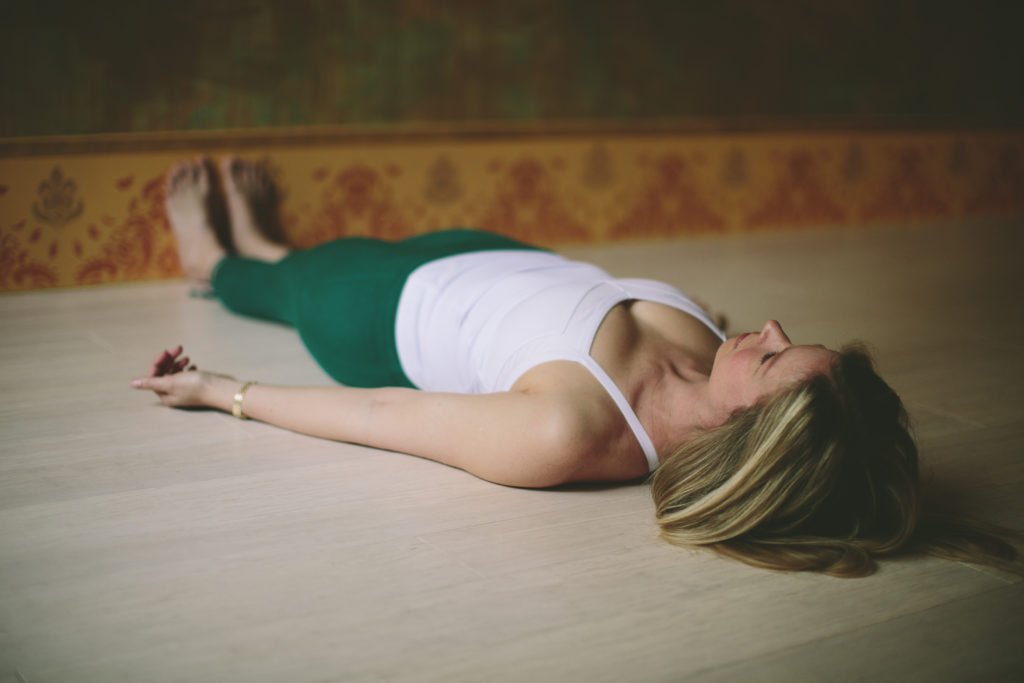
Lie down on your back and place the soles of your feet against a wall. Wedge your heels into the crease of the wall and floor. Bend your knees slightly and wiggle your pelvis and torso a little closer to the wall; push your feet into the wall in order to straighten your knees—this will give you the sense that your feet are plugged into the wall.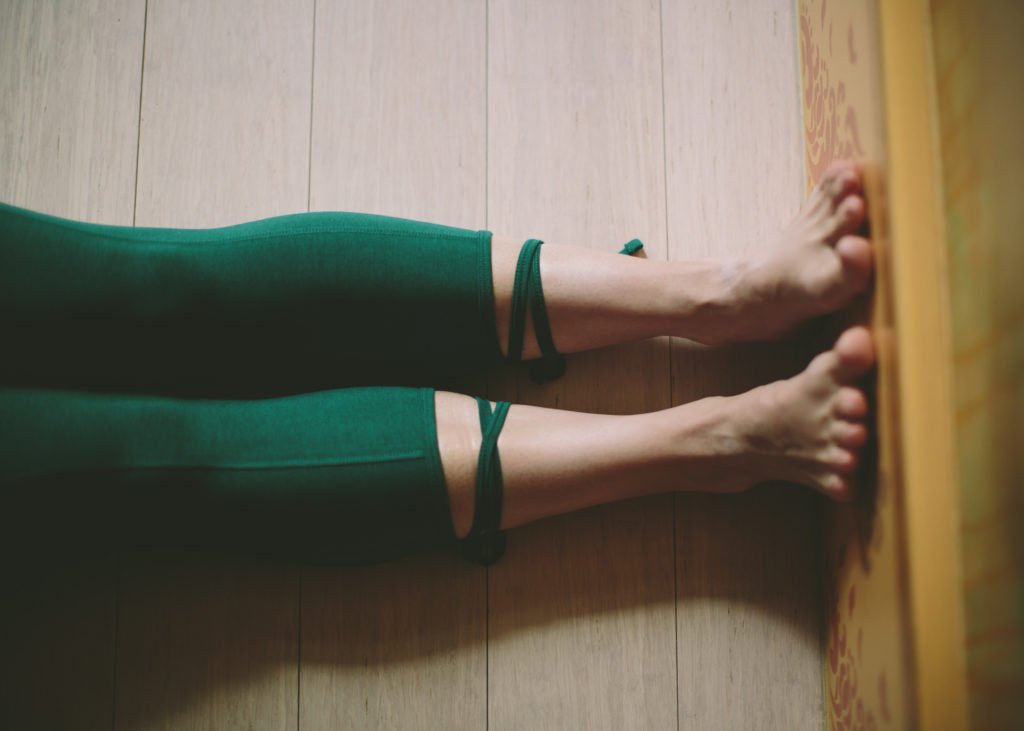
Connect all four corners of the feet into the wall—the inner and outer heels, the big toe mounds and the little toe mounds. As you press your feet into the wall, pull the thighs up. Ground the big toe mounds into the wall as you release the outer shins and outer upper thighs down into the floor. Roll the upper inner thighs down towards the mat as you hug the outer thighs in.
Supta Padangusthasana 1 + 2 with Standing Foot at Wall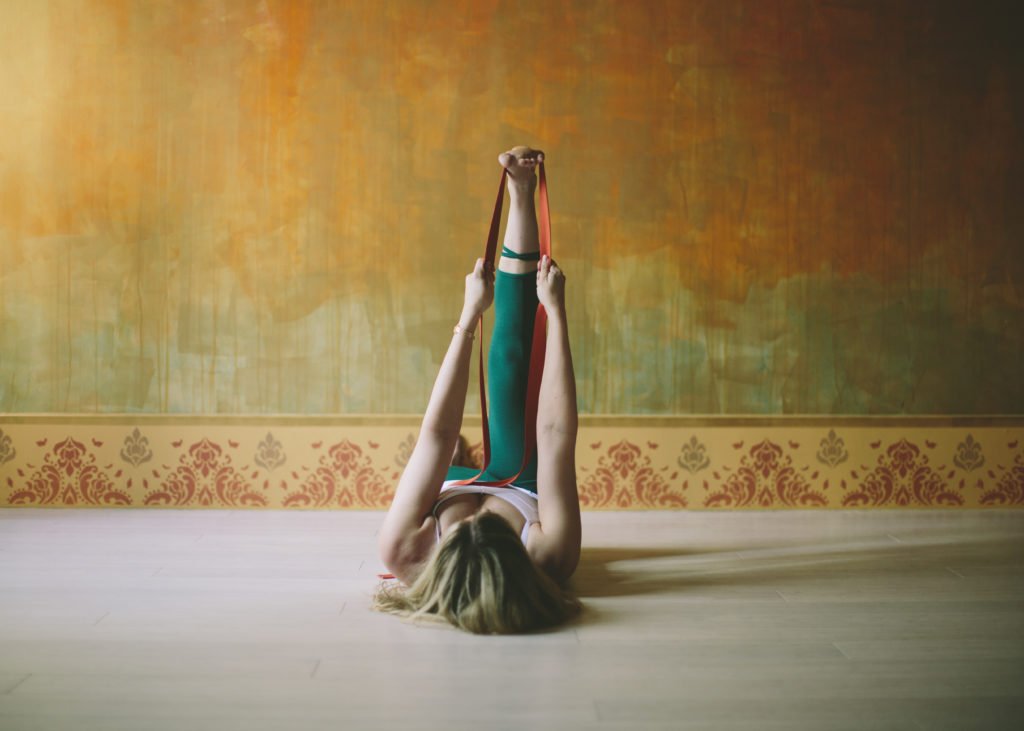
Repeat the instructions outlined above for Supta Tadasana. Bend your right knee into your chest. Place a strap around the ball of the right foot and extend the right leg up towards the ceiling. Draw the right greater trochanter towards the right sit bone, moving the outer right hip in the direction of the wall. 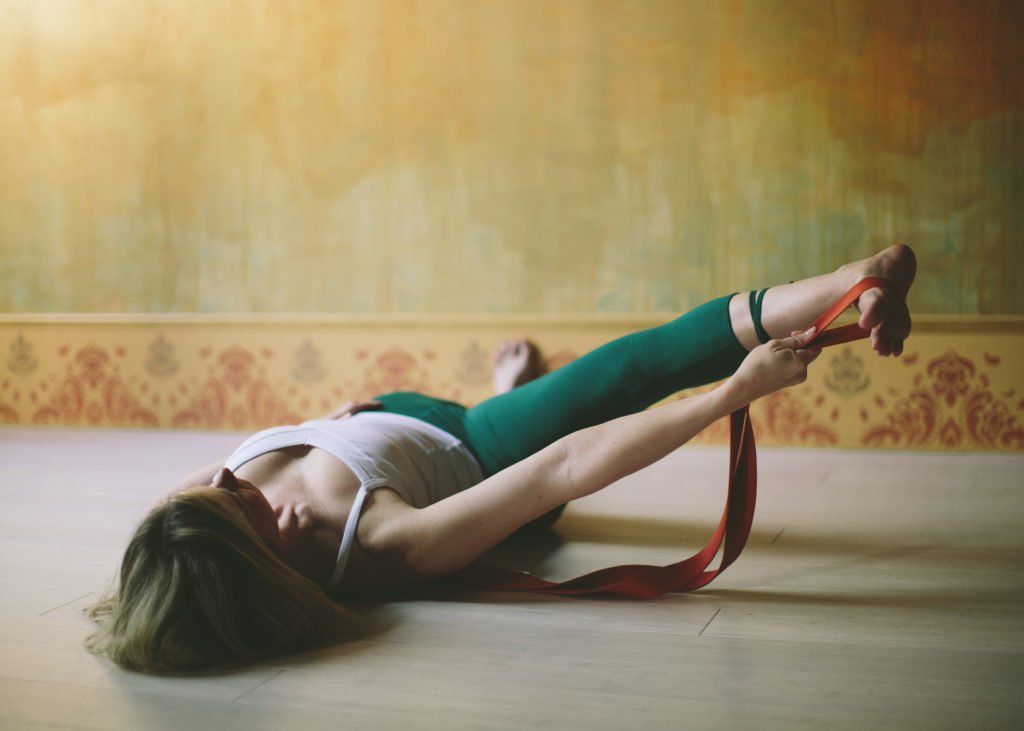
Rotate the right thigh externally as you take the leg out to the side into Supta Padangusthasana 2. Firm the standing outer hip in towards the midline as you lengthen the inseam of the standing leg all the way down into the inner left heel.
Supta Padangusthasana 2 with Lifted Foot at Wall 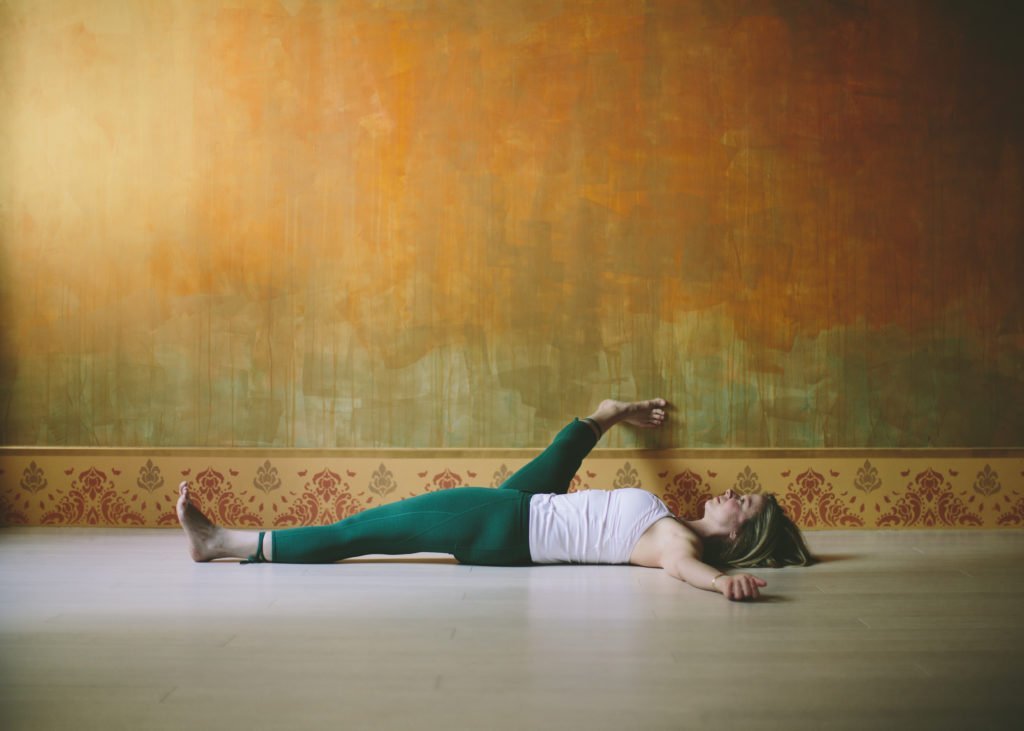
Lie down with the wall to your right. How far you set up away from the wall will depend on the length of your legs as well as the range of motion available to you at the hip joint and in your adductors (inner thighs). Place your right foot on the wall. Like in Supta Tadasana, you can start a hair closer to the wall with your right knee slightly bent so that you can push your right foot into the wall and feel yourself “plugged” into position. Press the right inner heel and big toe mound into the wall. Externally rotate the right thigh deep inside the right hip socket. Draw the right outer hip towards the bottom heel.
Upavistha Konasana with Back Against Wall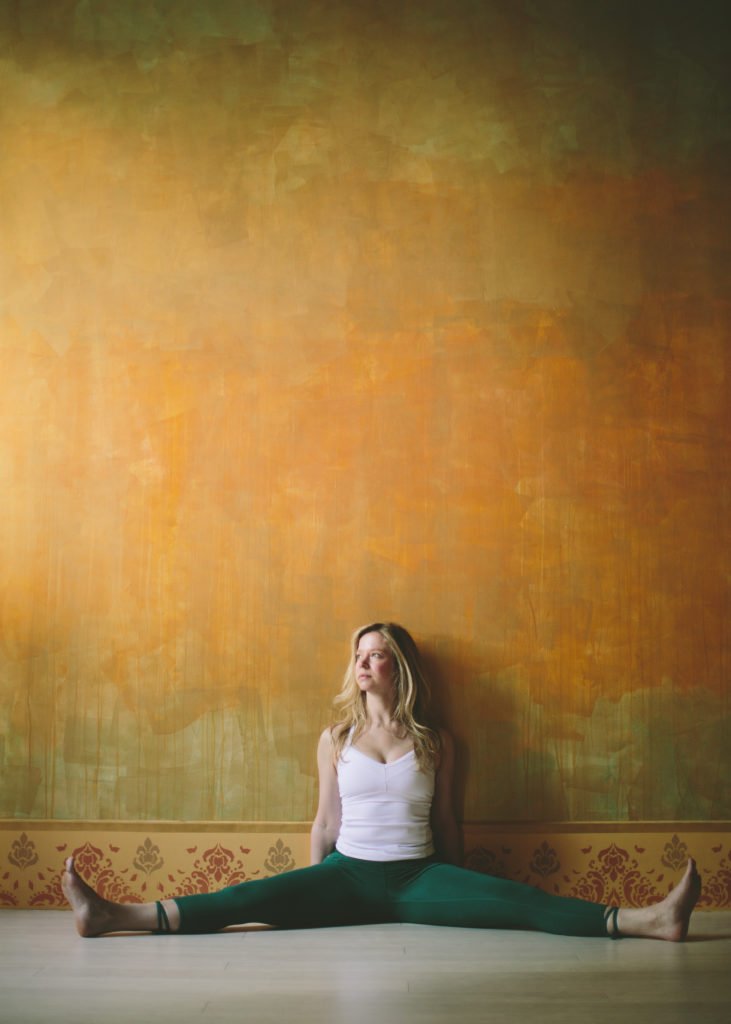
Sit with your back against the wall and extend both legs out to the side into Upavistha Konasana. If you feel like you’re rolling towards the back of the sit bones, or if your tailbone feels like it’s tucking under, sit up on either one or two folded blankets in order to create more space to sit upright and maintain the natural curves of the spine. Reach out through the inner heels and big toe mounds. Draw the outer heels strongly into the outer hips. Release the inner and outer upper thighs down towards the floor at the same speed.
Baddha Konasana with Back Against Wall 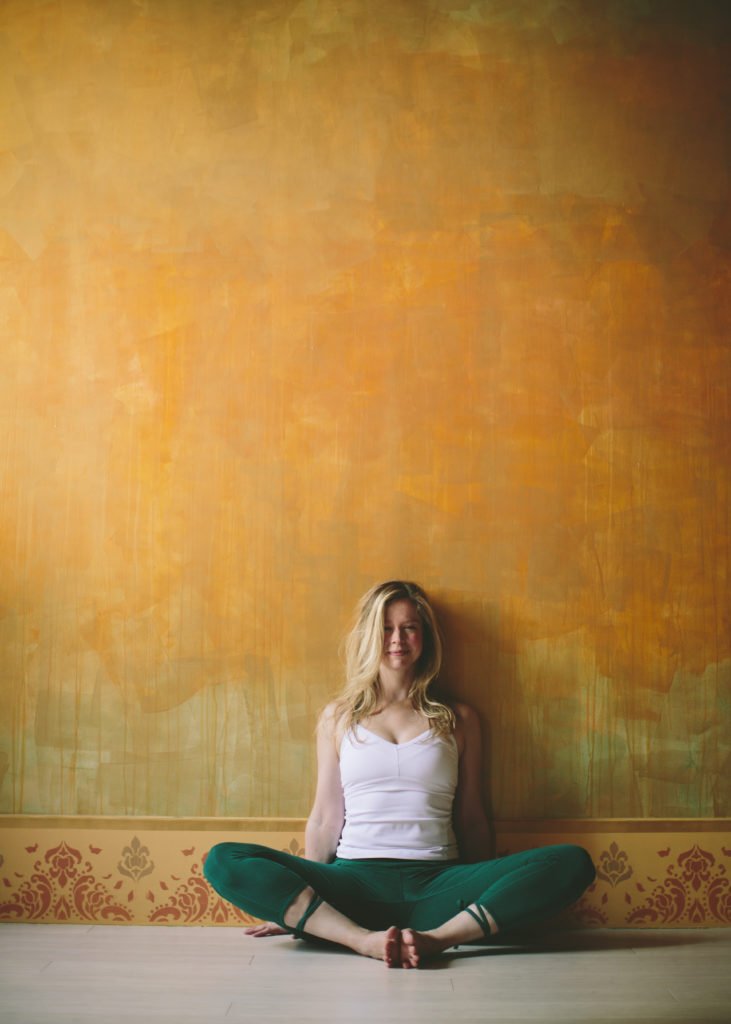
Sit with your back against a wall. Bend your knees and place the soles of your feet together. Press the inner edges of the feet together as you lengthen the inner thighs in the opposite direction. Reach the inner knees towards the sides of the room; draw the outer knees into the outer hips.
Malasana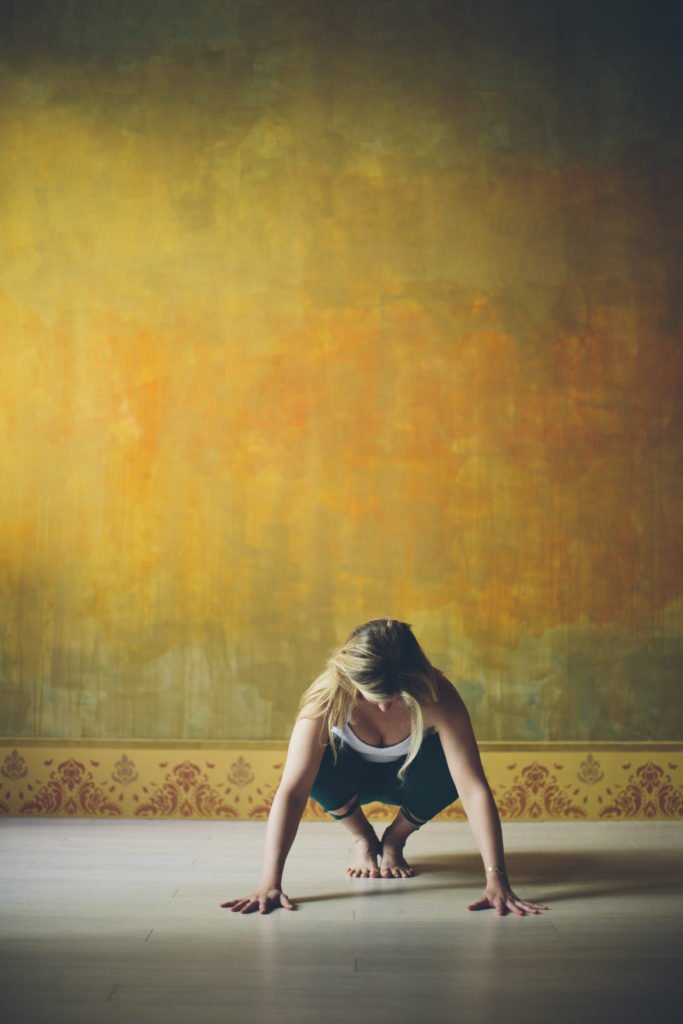
To come into Malasana from Baddha Konasana, bring your hands to your outer knees and draw the thighs together. Shift your weight forward and roll onto the balls of your feet. To come into Malasana from Uttanasana, slowly bend your knees and come into a deep squat. You can place a folded blanket under your heels if they don’t comfortably touch the floor. Release the ribcage down inside the inner thighs.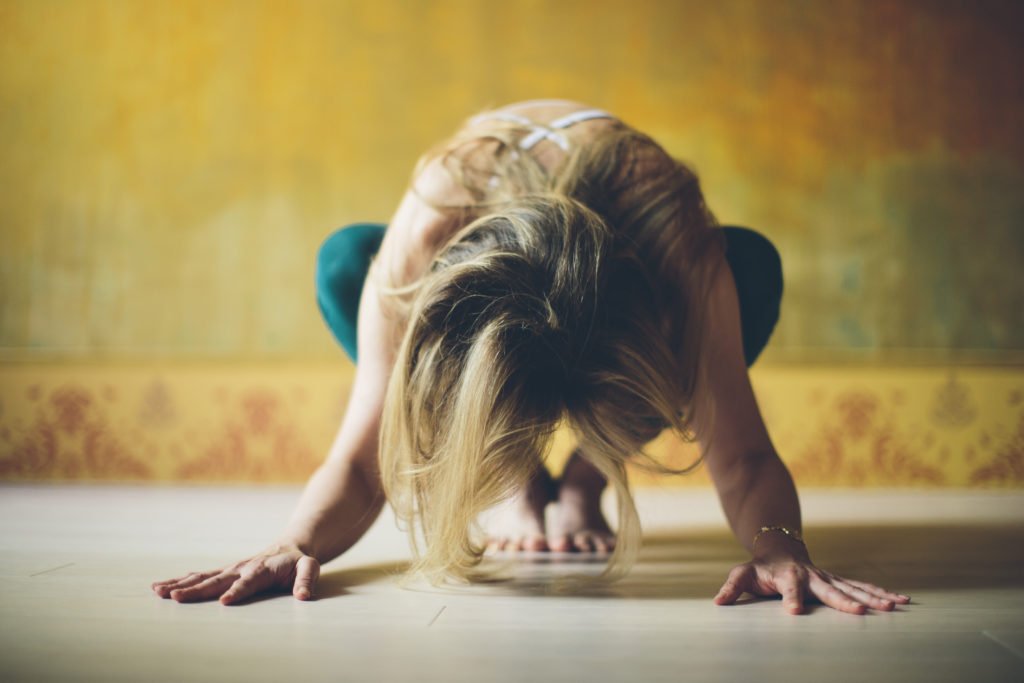
Hang the head. Ground the big toe mounds into the mat. Heavy the inner heels towards the floor; notice how this draws the inner thighs into the hip sockets. Hug the outer upper thighs in towards the shoulders.
Tadasana in Relève 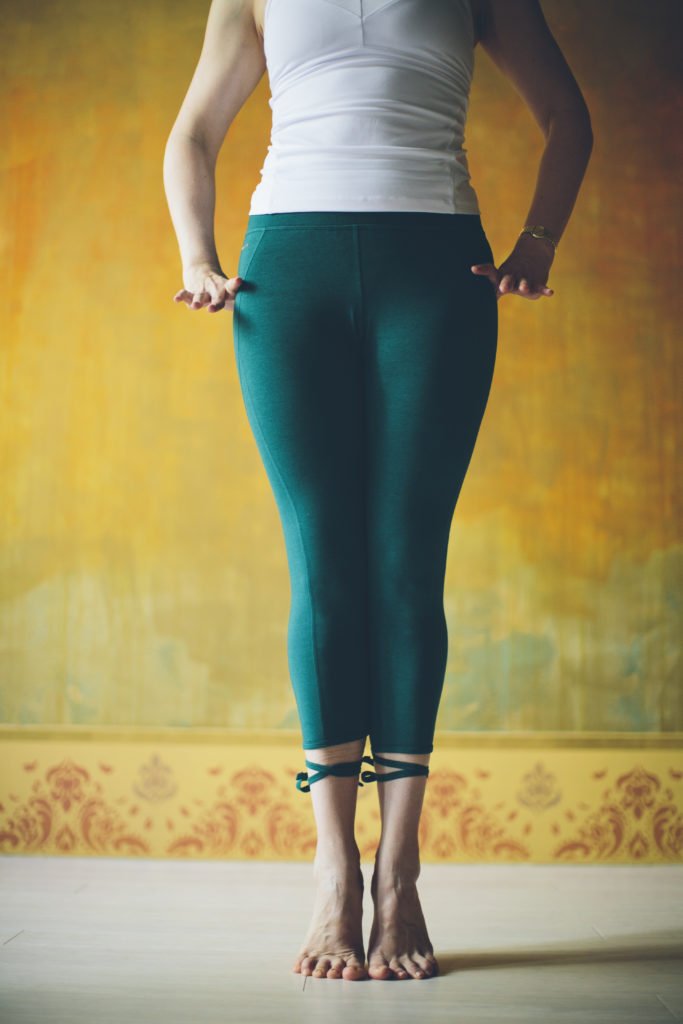
Stand in Tadasana with your feet together. Alternatively, you can place a block between your feet and ankles to encourage more space and stability. If you’d like support in the balance, place your fingertips on a wall or a stable piece of furniture. Rise high up onto the balls of your feet.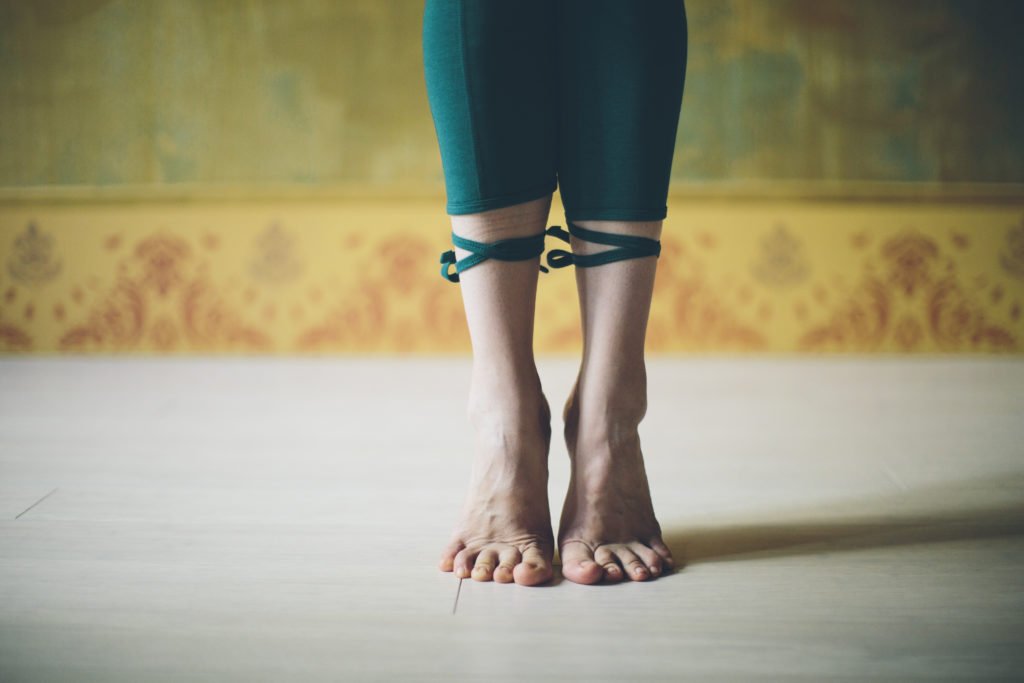
Pin the big toe mounds into the floor. Hug the outer ankles in towards each other. Wrap the outer shins back and around as you release the upper inner thighs back. Firm the outer hips in and draw the greater trochanters towards the sit bones.
Tadasana with Block Between Thighs and Strap Around Thighs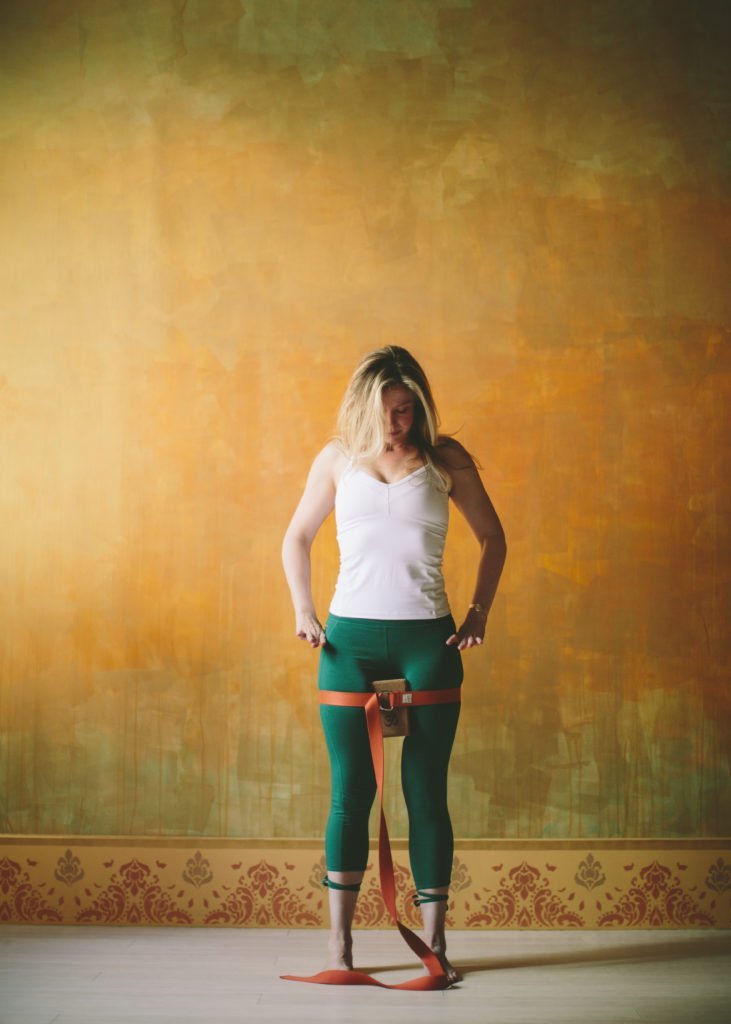
Place a block between your upper inner thighs. Loop a strap snugly around your mid thighs, directly between the hip and knee joints. Squeeze the block by hugging the outer upper thighs in. Hold for three breaths. Press out into the strap by resisting the inner upper thighs out. Hold for three breaths. Repeat both actions three times. Lastly, attempt to do both simultaneously. Hold for three breaths. Repeat three times.
Uttanasana with Blo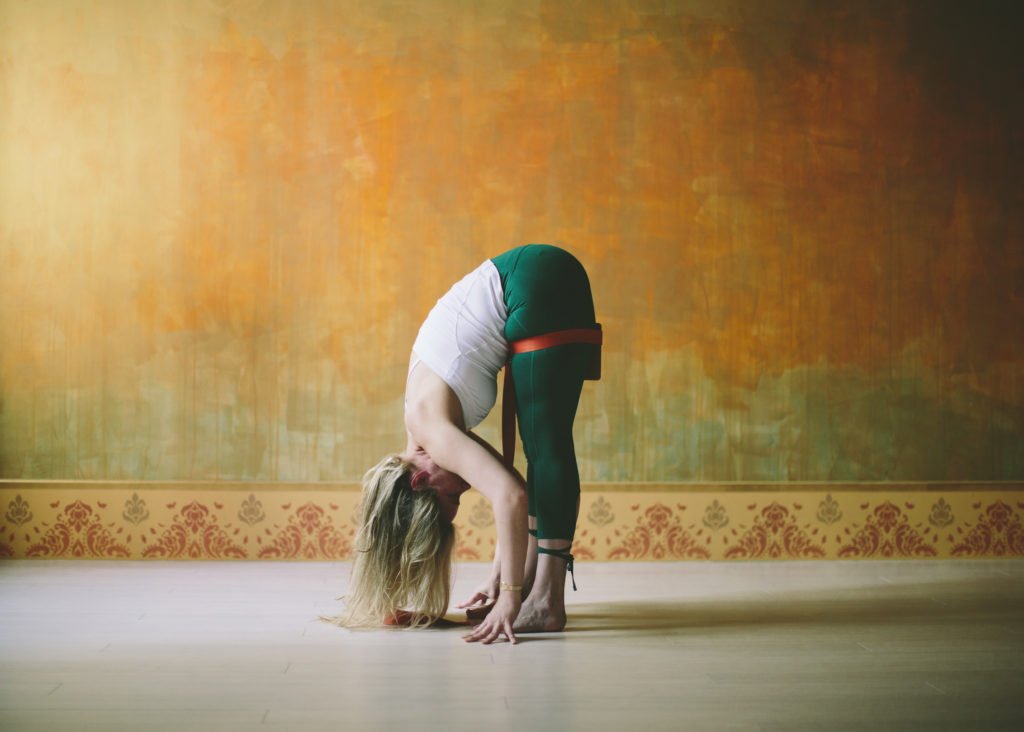 ck Between Thighs and Strap Around Thighs
ck Between Thighs and Strap Around Thighs
From Tadasana, hinge forward at the hip joints into Uttanasana. Squeeze the block by hugging the outer upper thighs in. Hold for three breaths. “Break” the strap by resisting the inner upper thighs out. Hold for three breaths. Do both actions simultaneously. Hold for three breaths.
Trikonasana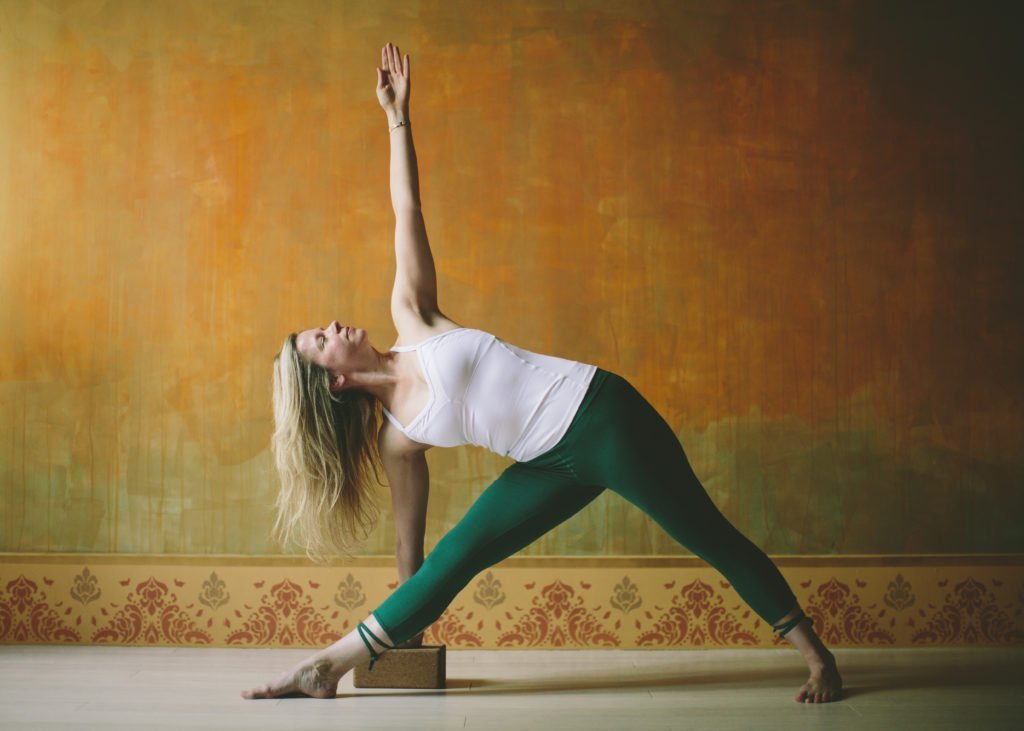
Start in Tadasana. Step or jump your feet wide apart. Extend your arms out to the side at shoulder height. The feet line up approximately under the wrists. Turn the back toes in 15 degrees. Rotate the front thigh and foot out externally 90 degrees. Inhale, ground down into the feet and pull up through the thighs as you did in Tadasana Relève. On an exhalation, draw the right greater trochanter towards the back heel as you lengthen all four sides of the torso towards the front foot. Place your bottom hand on a block outside your front foot, or place your hand on your ankle, or the floor behind your foot.
Soak the inner edge of the front foot into the mat. For those who hyperextend the knees, it can be helpful to bend the front knee by resisting the calf up into the shin bone; this brings heaviness to the heel, which can be directed into the inner corner of the heel bone. Straighten the front knee not by slamming the knee down towards the floor, but by pulling the quadriceps up and drawing the greater trochanter of the right thigh back towards the left heel. Spin the right sit bone underneath you as you continue to anchor the right inner heel down into the floor. Lengthen the right big toe away from the inner heel.
Vrksasana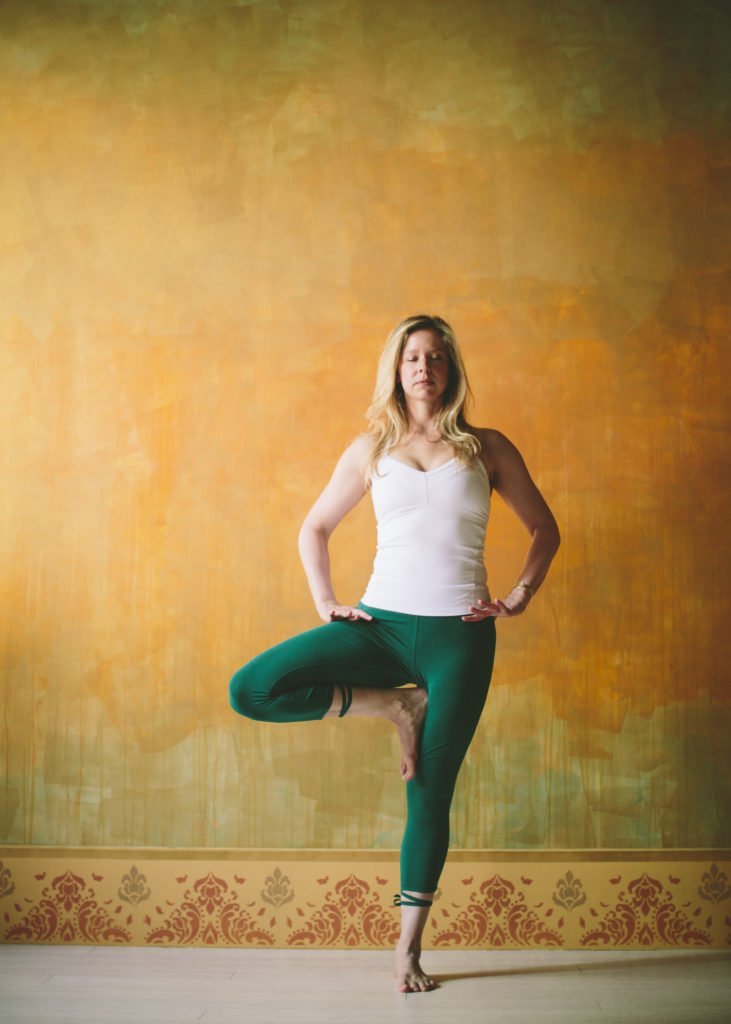
Start in Tadasana. Shift your weight into the left foot and hug the right knee into your chest. Externally rotate the right thigh in the hip socket. Place the sole of your the foot high up on the inner upper standing thigh, or the inner shin below the knee. Place your hands on your hips to bring awareness to the alignment of the pelvis. Ground the standing foot down into the floor as you pull the standing thigh up. Firm the standing outer hip in as you draw the outer right hip down. Press the right foot into the standing thigh. Lengthen right inner thigh from the pubic bone all the way out to the inner knee. Firm the outer knee and draw it towards the right sit bone.
Utkatasana with Strap Around Thighs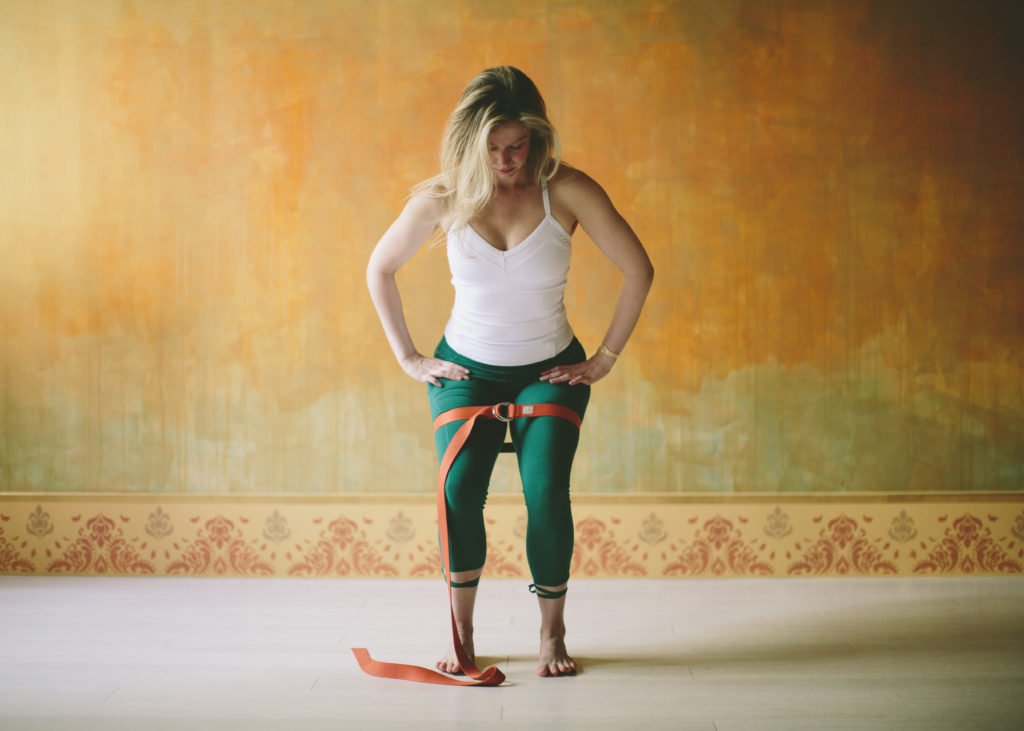
Loop a strap snugly around your mid thighs, between the hip and knee joints. Bend your knees and sit back as if into a chair coming into Utkatasana. Press the shin bones back into the calves; ground the calves down into the heels. Press the inner heels down as you resist the inner upper thighs out into the strap. Firm the outer hips in as you release the inner upper thighs down.
Parivrtta Trikonasana
Stand in Tadasana facing the long edge of your mat. Step or jump your feet wide apart, approximately three to four feet. Place your hands on your hips. Turn the left toes in 45 degrees. Rotate the right thigh and foot out 90 degrees. Turn your whole body to face the right. Adjust the back foot slightly to the left (or toe-heel the front foot slightly to the right) so you can align the inner heels along or (for more space and stability) slightly wider than the center line of your mat. Ground down into the back outer heel and press the back thigh back. Root into the big toe mound and inner heel of the front foot as you draw the right outer upper thigh back towards the wall behind you. On an exhalation, hinge forward at the hip joints and extend all four sides of the torso forward over the front thigh. Bring your hands to the floor or blocks on either side of the front foot. Press down into your feet and pull both thigh bones up.
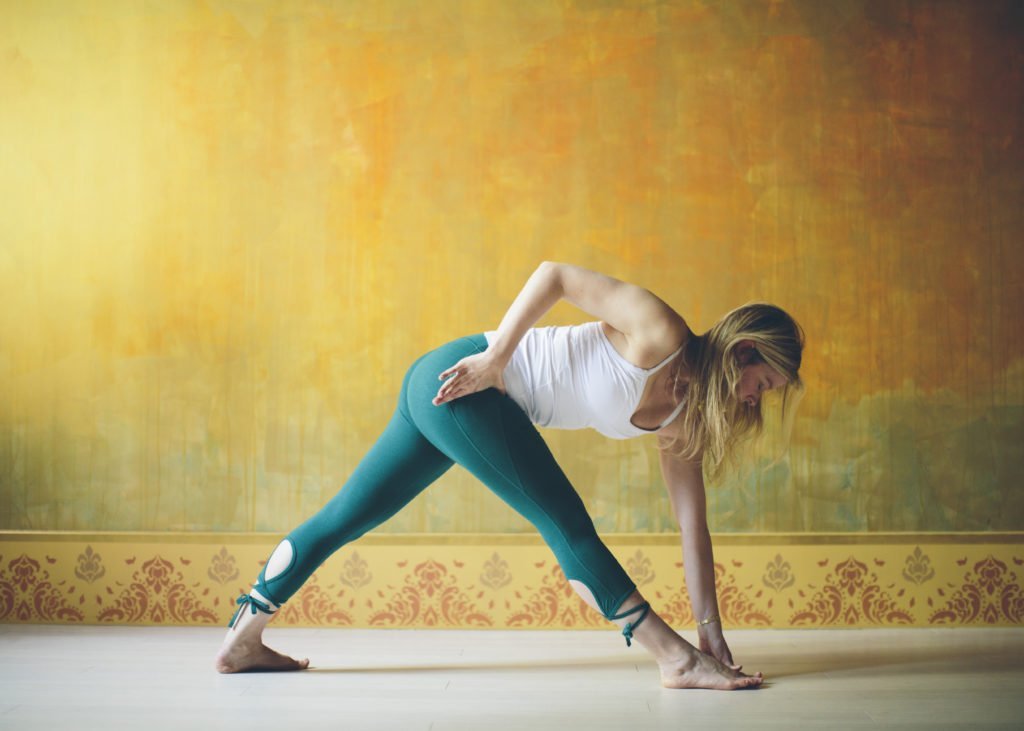
Slip your right thumb into the right hip crease, wrapping your other four fingers around the outer hip. Use your hand to draw the greater trochanter of the right outer thigh back and around towards the right sit bone. As the right outer hip moves towards your back heel, notice how the right side of your waist and lower abdomen elongate. If you feel steady in your balance, place your left thumb on the mound of the right big toe (you can bend your front knee if you can’t reach easily).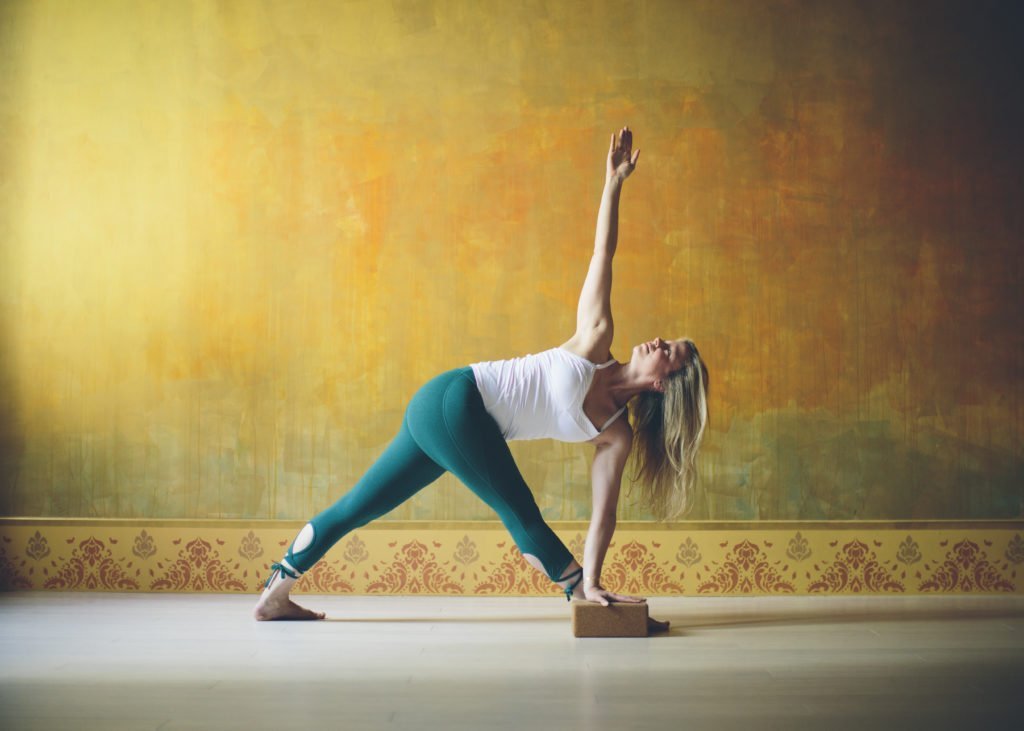
Meditate on these two opposing forces. Do not prioritize one over the other, rather tend to both with equal attention.
Padangusthasana
Stand in Tadasana with your feet hip distance apart. Place your hands on your hips and hinge forward into Uttanasana. Slip your second and third fingers inside your big and second toes and wrap them underneath the big toes. Join the tips of your thumbs with the tips of the second and third fingers to create a mudra, or seal. Inhale, pull up on the big toes to straighten your arms. Draw your sternum through your upper arms; spread your collar bones wide apart. On your exhale, bend your elbows out to the sides any amount, lengthening your spine out of your pelvis.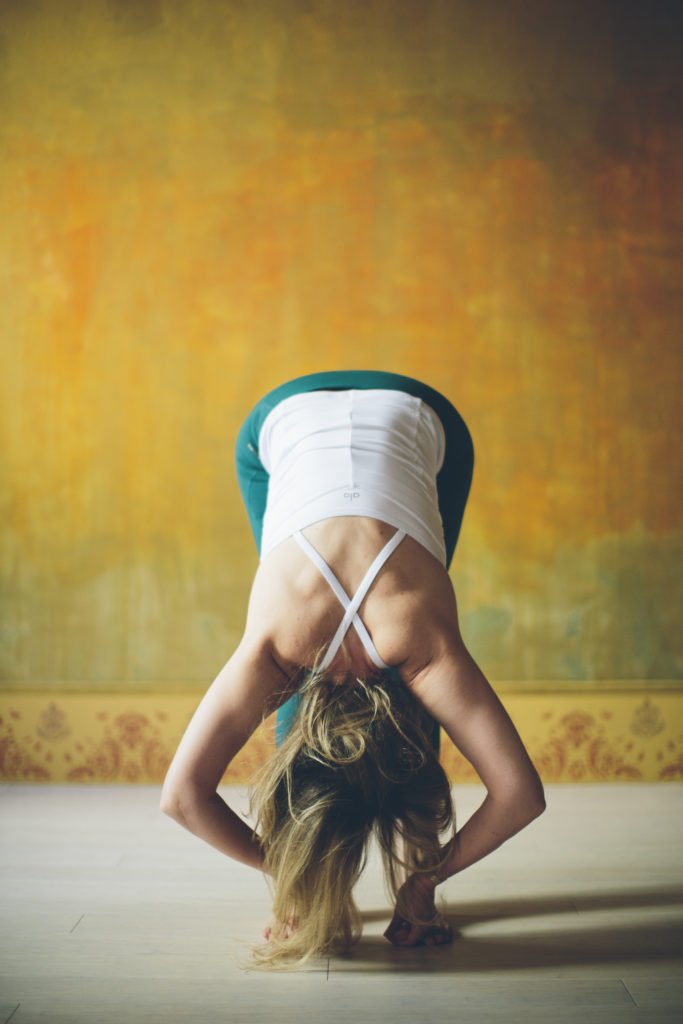
Ground down into the big toe mounds as you pull up with your fingers, as if you’re trying to lift your big toes off the floor.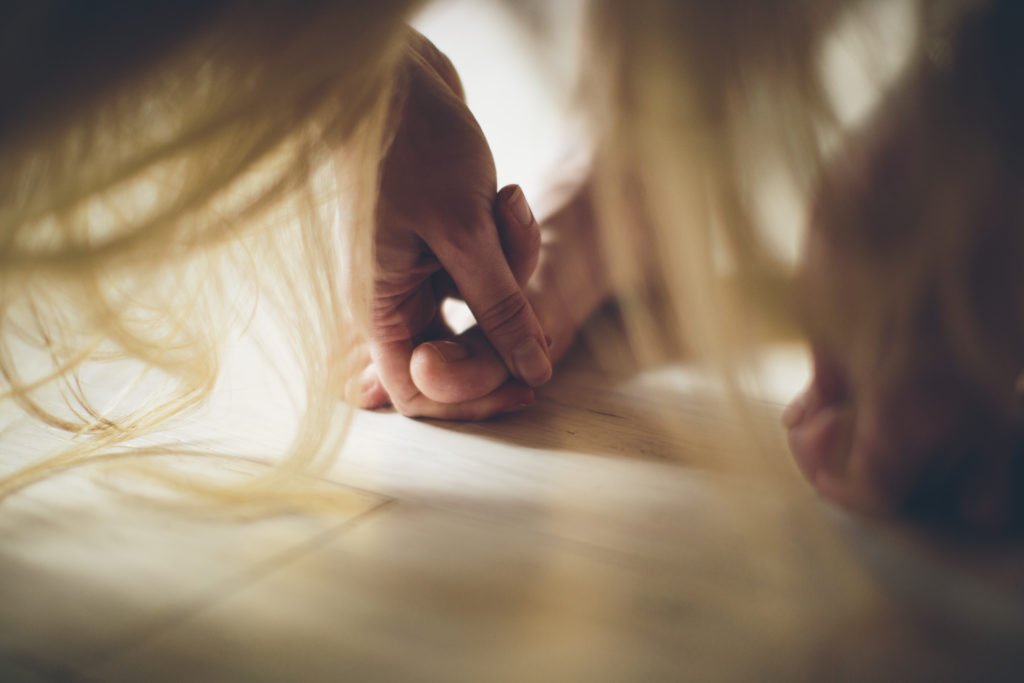
Hug the outer ankles in as you lift the inner arches of the feet up to the inner knees. Wrap the outer shins back. Find the opposing actions cultivated in Tadasana and Uttanasana with the block and the belt. Pull up through the legs as if you were in relève. Firm the outer hips in. Draw the greater trochanters back as you release the upper inner thighs towards the wall behind you.
Utthita Hasta Padangusthasana
Start standing in Tadasana, hands on your hips. Shift your weight into the left foot; bend the right knee into your chest. Reach with the right hand and clasp the right big toe with the second and third fingers, as in Padangusthasana. Ground down into the big toe mound of your standing foot an pull up through the standing inner thigh. Draw the right outer upper thigh down towards the floor as you firm the standing outer hip in. Draw the right upper arm onto the upper back as you root the right big toe mound into the fingers. Slowly extend the right knee any amount. Prioritize the actions over any arbitrary destination—specifically, the idea of straightening the right knee; the stability and integrity of the pose comes from a sustained attention of the actions that integrate the body.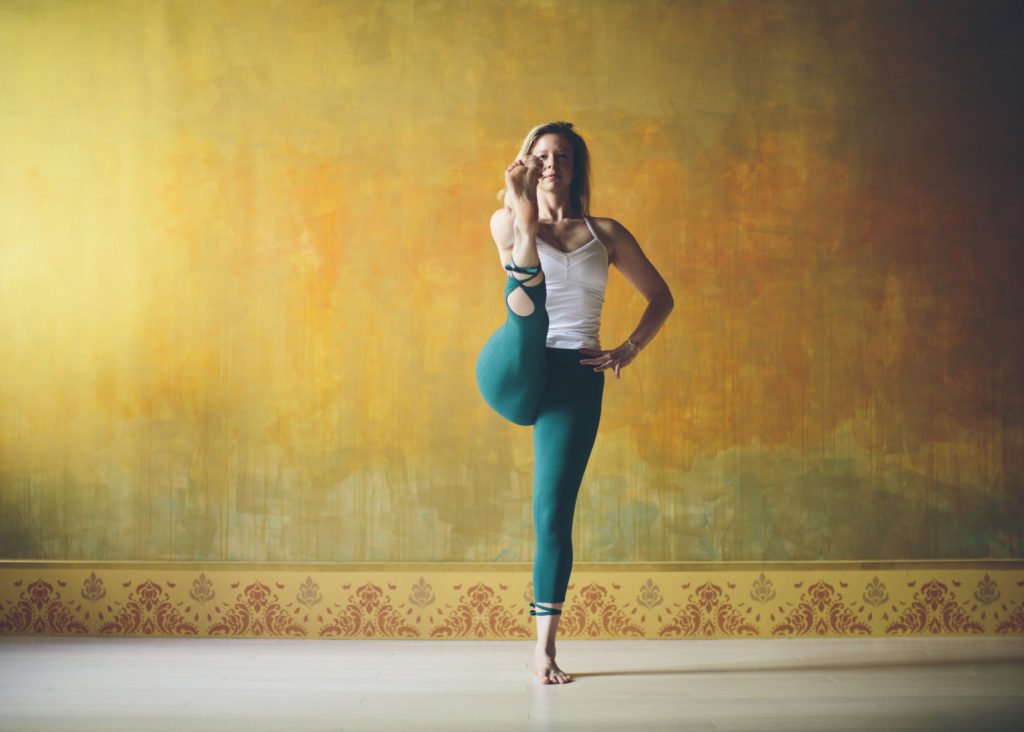
Press the big toe mound of the aerial leg into the fingers. Draw the outer right thigh down; magnetize the greater trochanter towards the right sit bone. Anchor all four corners of the standing foot into the floor as you pull up through the standing thigh. Firm the outer standing hip in as you continue to draw the greater trochanter of the lifted thigh down towards the floor.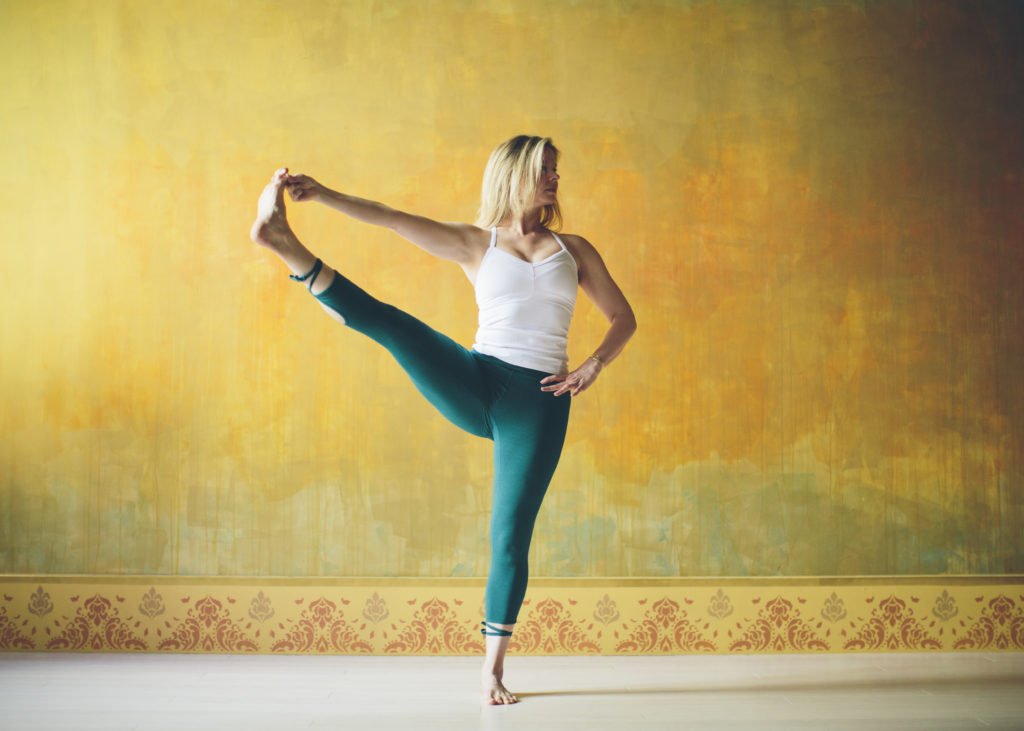
Slowly extend the right leg into Utthita Hasta Padangusthasana 2. Externally rotate the right thigh deep inside the right hip socket. Firm the standing outer hip in as you draw the right outer hip down towards the floor. Reconnect to the actions of Baddha Konasana—lengthen the inseam of the right inner thigh all the way out to the big toe mound, pressing the big toe mound out into your fingers; then draw the outer edge of the right foot all the way up to the right outer hip. As you press the big toe mound into your fingers, pull the right upper arm onto the back ribs. Turn your gaze to the left.
Bring the leg back to center. Slowly lower the leg back to Tadasana.
Prasarita Padottanasana D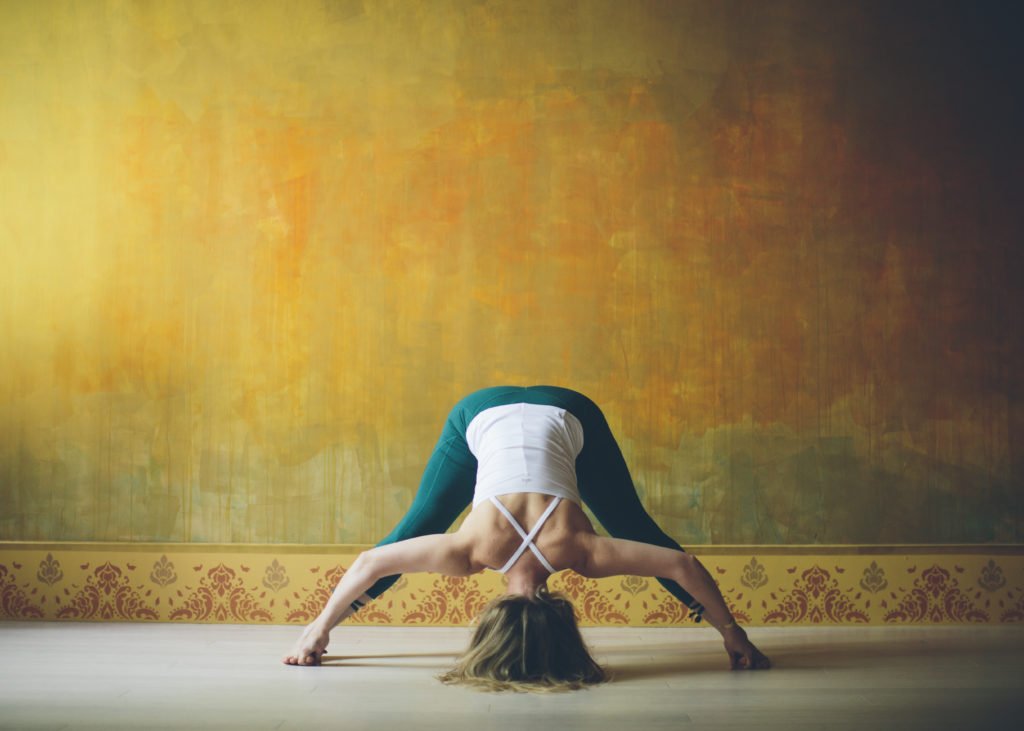
Stand in Tadasana. Step or jump your feet wide apart. Stretch your arms wide apart; the feet align approximately under the hands. Spread the collarbones and shoulder blades apart. Place your hands on your hips. Before hinging forward at the hips, focus on the actions of the feet and legs: Ground down into inner edge of the feet as you wrap the outer shins back. Lift the inner thighs up as you firm the outer hips in. On an inhalation, press the feet down and rebound up through the crown of the head. On an exhalation, hinge forward at the hip joints and extend the spine forward over the thighs. Clasp the fingers around the big toes as you did in Padangusthasana. Inhale, pull up on the big toes to straighten your arms. Draw the sternum through the upper arms; spread the collar bones wide apart. On an exhale, bend the elbows out to the sides any amount, lengthening the spine out of the pelvis.
Sharpen the inner heels. Press the big toe mounds down into the floor as you lift the inner arches of the feet up towards the inner knees. Swipe the outer shins back. Release the flesh of the inner upper thighs back. Hug the outer hips in and draw the greater trochanters towards the sit bones.
Ankle-to-Knee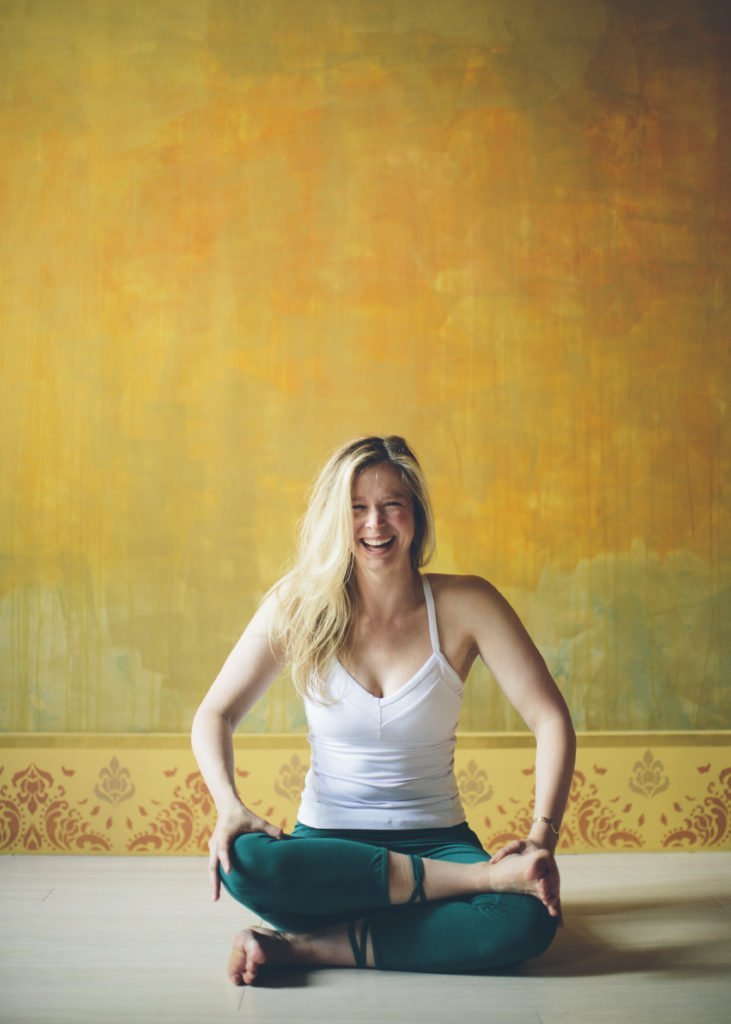
Sit in Dandasana. Bend the right knee, externally rotate the right thigh at the hip joint to cross the right ankle over the left thigh directly above the knee. Lean back on your hands to bend the left knee; externally rotate the left thigh at the hip joint and slide the left foot under the right knee.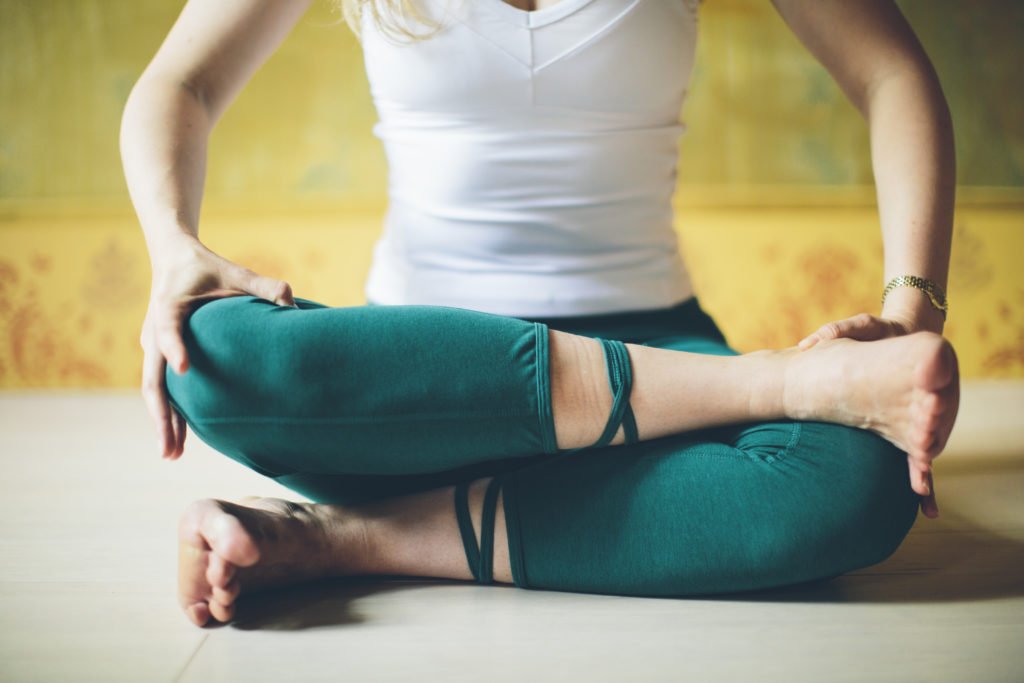
Take your left thumb to the inner heel and your right thumb into the crease of the inner knee. Pull these two points apart, lengthening the inner leg.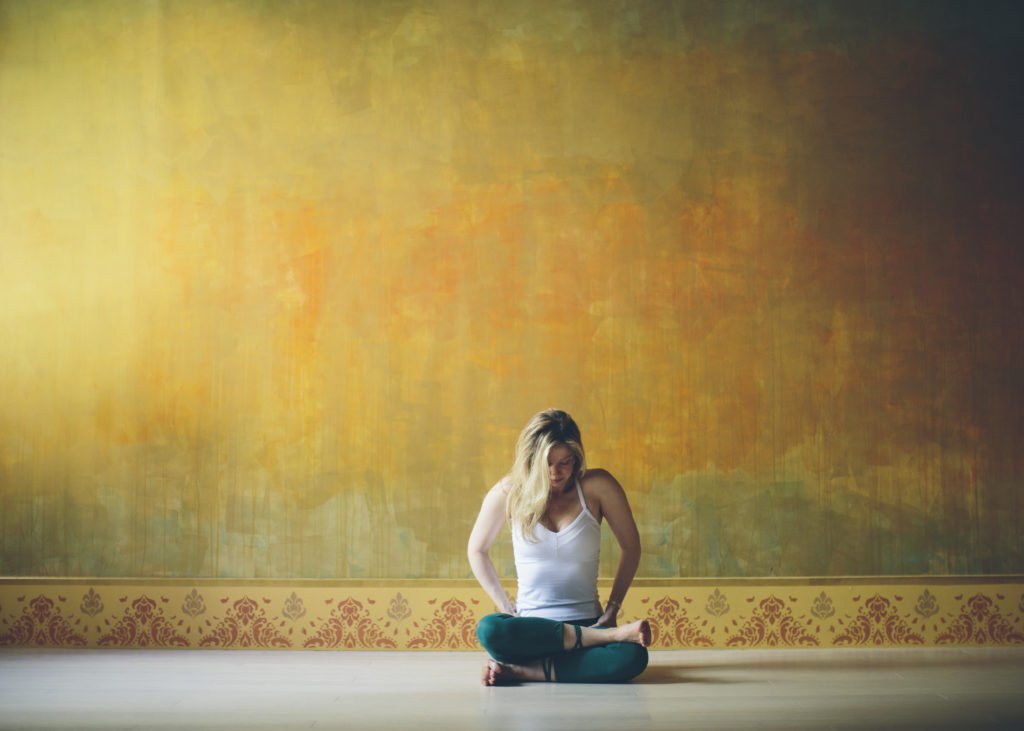
Place your hands into the hip creases and press down; rebound up out of the pelvis, extending the sides of the waist. Heavy the tailbone towards the floor and hinge forward any amount.
Photos by Hailey Wist
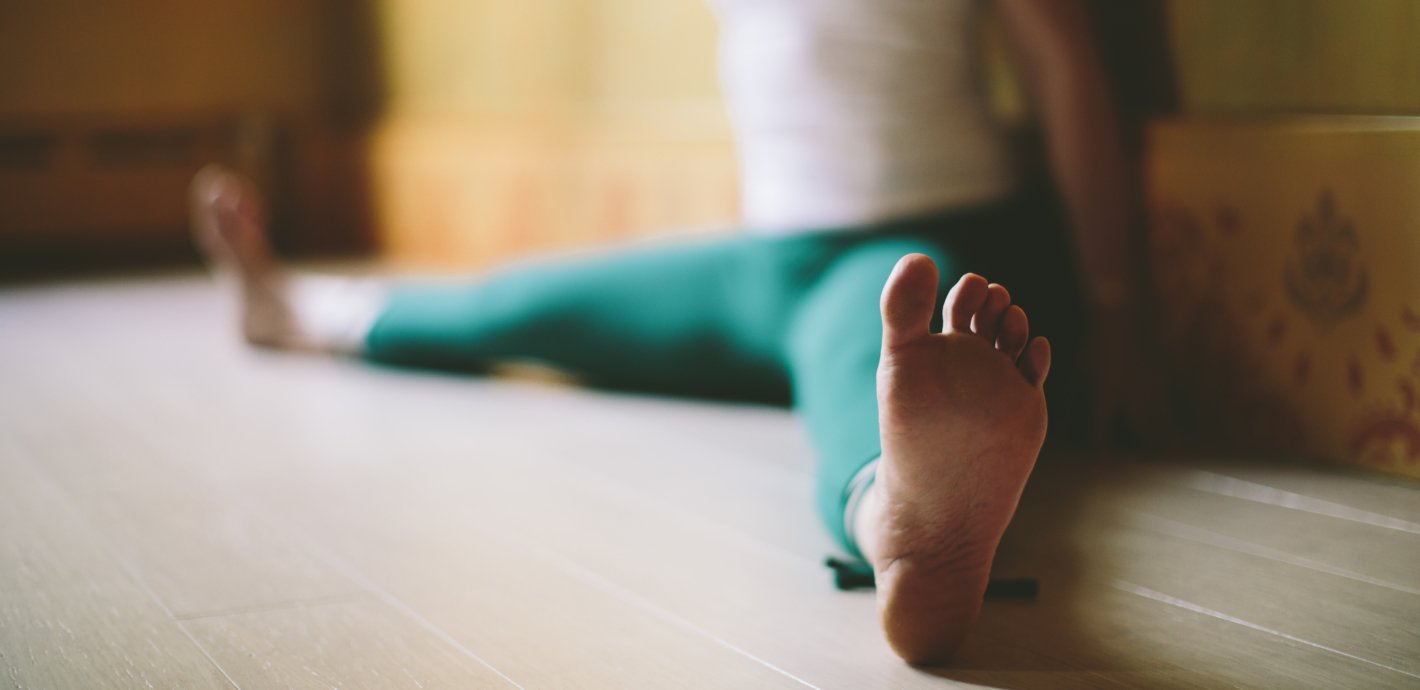

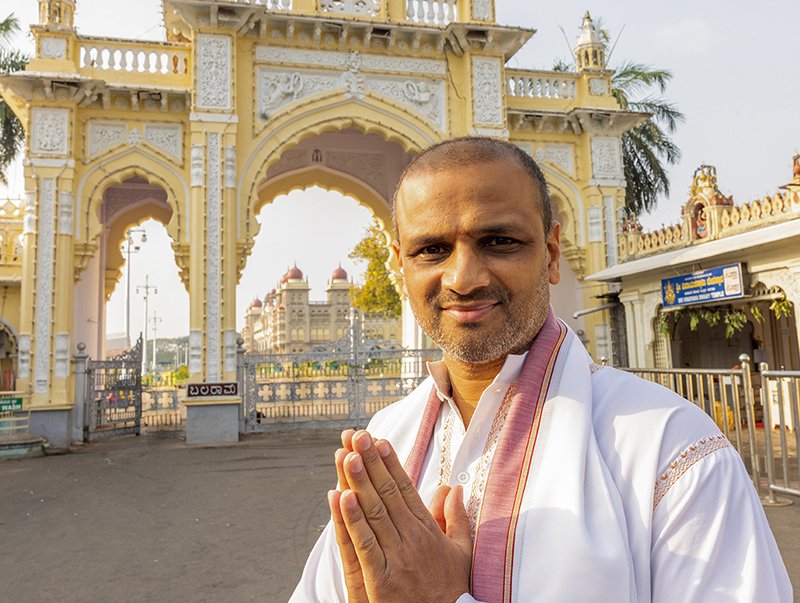
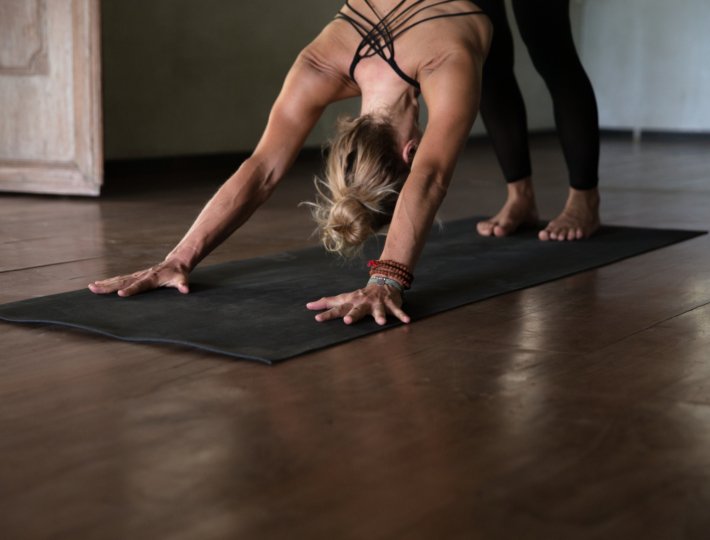
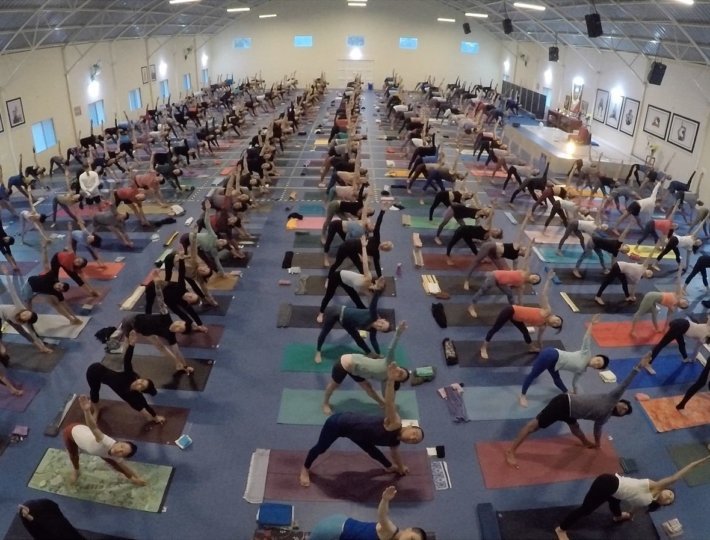

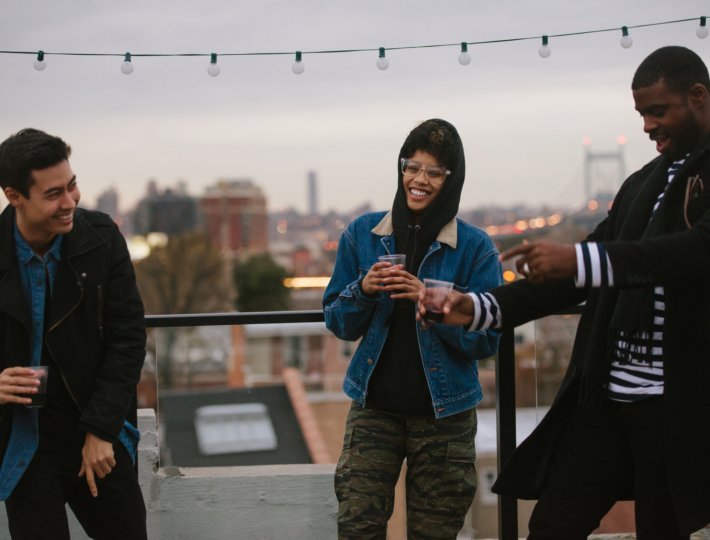
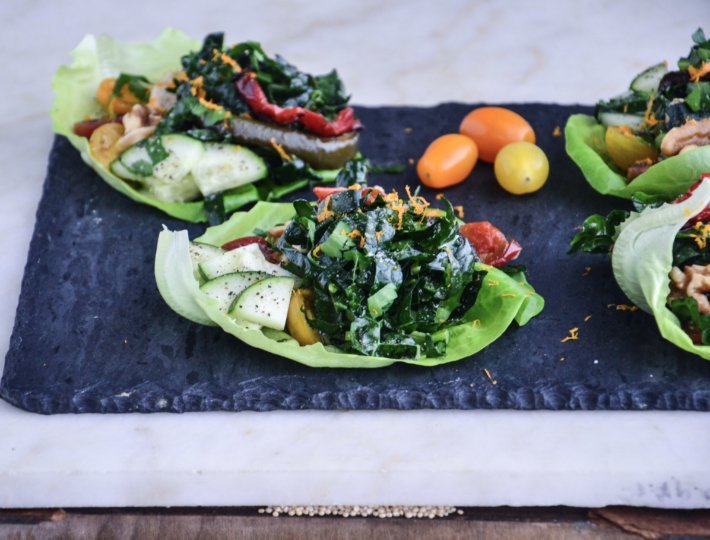
Comments (0)